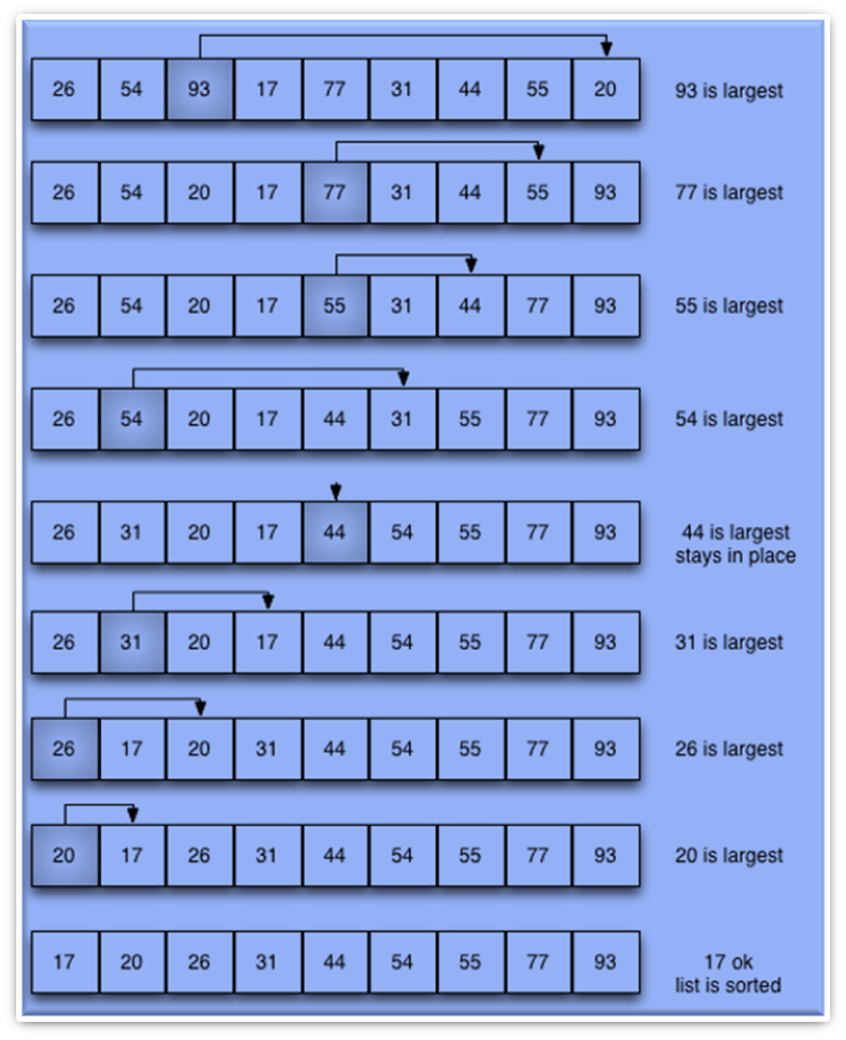The algorithm divides the input list into two parts: a
sorted sublist of items which is built up from left to right at the front
(left) of the list and a sublist of the remaining unsorted items that occupy
the rest of the list. Initially, the sorted sublist is empty and the unsorted
sublist is the entire input list. The algorithm proceeds by finding the
smallest (or largest, depending on sorting order) element in the unsorted
sublist, exchanging (swapping) it with the leftmost unsorted element (putting it
in sorted order), and moving the sublist boundaries one element to the right.
java
|
package
com.kartik.sorting; |
The provided code is an implementation of the Selection Sort
algorithm in Java. This implementation also includes the ability to print the
array before and after each sorting step, allowing you to observe how the
algorithm progresses.
Explanation of the Code:
- Selection
Sort Algorithm:
- The
selection sort algorithm divides the input array into two parts: a sorted
subarray and an unsorted subarray. Initially, the sorted subarray is
empty, and the unsorted subarray is the entire input array.
- The
algorithm repeatedly selects the smallest (or largest, depending on
sorting order) element from the unsorted subarray and swaps it with the
first element of the unsorted subarray, thereby growing the sorted
subarray by one element.
- doSelectionSort
Method:
- Parameters:
Takes an integer array arr as input.
- Logic:
- The
outer loop runs from the first to the second-to-last element of the
array.
- For
each element, the inner loop finds the smallest element in the unsorted
portion of the array.
- The
smallest element is then swapped with the first element of the unsorted
portion, effectively moving it to the sorted portion.
- After
each iteration, the current state of the array is printed to the console.
- printNumbers
Method:
- A
utility method to print the current state of the array to the console.
- main
Method:
- Creates
an array arr1 and calls the doSelectionSort method to sort the array.
- The
sorted array is then printed out.
Example Output:
When you run the code, it will print the array before
sorting, after each sorting step, and the final sorted array.
plaintext
|
Before
Selection Sorting --->> 10, 34, 2,
56, 7, 67, 88, 42, After
Selection Sorting start--->> 2, 34, 10,
56, 7, 67, 88, 42, 2, 7, 10, 56,
34, 67, 88, 42, 2, 7, 10, 34,
56, 67, 88, 42, 2, 7, 10, 34,
42, 67, 88, 56, 2, 7, 10, 34,
42, 56, 88, 67, 2, 7, 10, 34,
42, 56, 67, 88, |
Explanation of the Output:
- Initial
Array: The initial state of the array before sorting.
- Sorting
Steps: After each iteration, you can observe how the smallest element
is moved to its correct position, and the sorted portion of the array
grows.
- Final
Sorted Array: After all iterations, the array is fully sorted in
ascending order.
Key Points:
- Time
Complexity: The time complexity of selection sort is O(n^2),
where n is the number of elements in the array. This makes it less
efficient than more advanced algorithms like merge sort or quick sort,
especially for large datasets.
- Space
Complexity: The space complexity is O(1), as the sorting is
done in-place without requiring additional memory.
- Stability:
Selection sort is not a stable sorting algorithm, meaning that the
relative order of equal elements might not be preserved.
Potential Enhancements:
- Generic
Implementation: Modify the implementation to work with generic types
instead of just integers.
- Optimizations:
Though selection sort is not the most efficient algorithm, consider
implementing optimizations or combining it with other algorithms for
better performance in specific scenarios.
- Visualization:
Integrate a visual representation of the sorting process, like the
tree-based visualization seen in the QuickSort example, to further enhance
understanding.
This code provides a straightforward example of how
selection sort works and allows you to visualize each step of the sorting
process in the console.










0 Comments